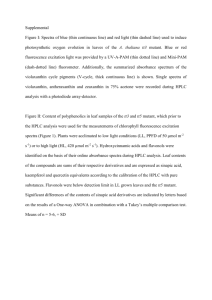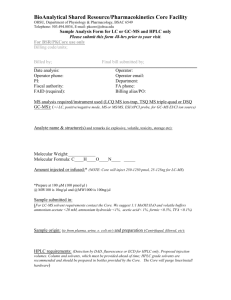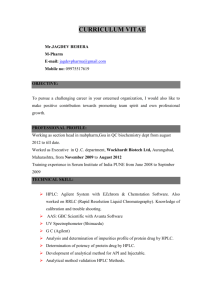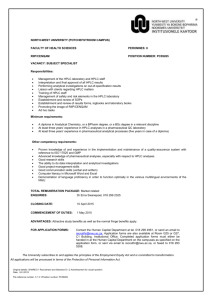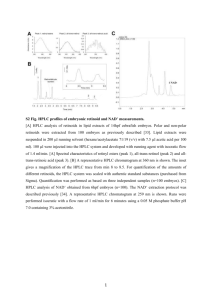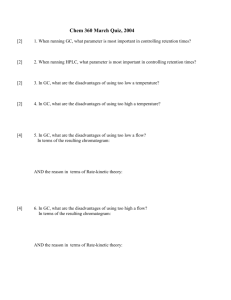Comparaison of chromatography and imunoassay - HAL
advertisement
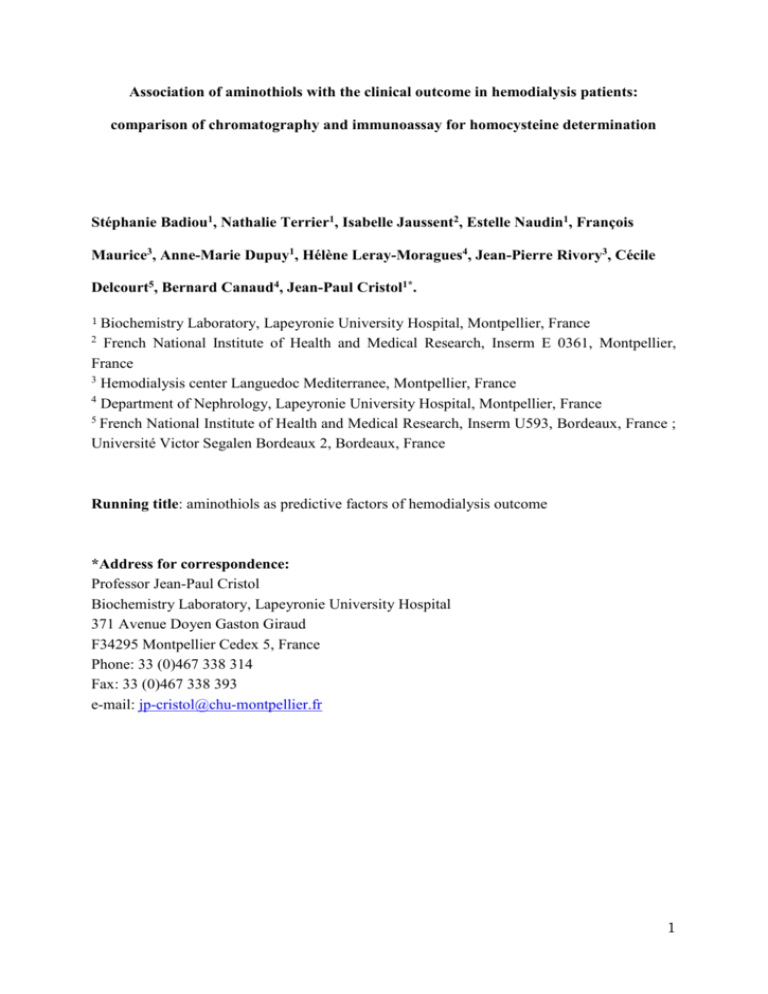
Association of aminothiols with the clinical outcome in hemodialysis patients: comparison of chromatography and immunoassay for homocysteine determination Stéphanie Badiou1, Nathalie Terrier1, Isabelle Jaussent2, Estelle Naudin1, François Maurice3, Anne-Marie Dupuy1, Hélène Leray-Moragues4, Jean-Pierre Rivory3, Cécile Delcourt5, Bernard Canaud4, Jean-Paul Cristol1*. 1 Biochemistry Laboratory, Lapeyronie University Hospital, Montpellier, France French National Institute of Health and Medical Research, Inserm E 0361, Montpellier, France 3 Hemodialysis center Languedoc Mediterranee, Montpellier, France 4 Department of Nephrology, Lapeyronie University Hospital, Montpellier, France 5 French National Institute of Health and Medical Research, Inserm U593, Bordeaux, France ; Université Victor Segalen Bordeaux 2, Bordeaux, France 2 Running title: aminothiols as predictive factors of hemodialysis outcome *Address for correspondence: Professor Jean-Paul Cristol Biochemistry Laboratory, Lapeyronie University Hospital 371 Avenue Doyen Gaston Giraud F34295 Montpellier Cedex 5, France Phone: 33 (0)467 338 314 Fax: 33 (0)467 338 393 e-mail: jp-cristol@chu-montpellier.fr 1 Abstract Background: Controversial results about hyperhomocysteinemia and cardiovascular (CV) risk in hemodialysis (HD) could be due in part to the methodology used for homocysteine (Hcy) determination. Objective: To compare the influence of the method used for Hcy determination (chromatography or immunoassay), in regard to the association of Hcy with CV mortality rate in HD patients in a 3 year prospective study. Methods: One hundred sixty-two patients undergoing HD were included in a cohort study. Baseline Hcy levels were measured by high performance liquid chromatography (HPLC) and fluorescence polarization immunoassay (FPIA). Cysteine and cysteinylglycine were determined simultaneously to Hcy measure by HPLC. Results: Hcy levels obtained with both methods were highly correlated (r2=0.927, p<0.0001). An increased relative risk (RR) for CV mortality (n=31) was found between the highest against lowest tertile of Hcy both with HPLC: 2.74 [1.07-7.02, confidence interval 95% (CI)] (p<0.05) and with FPIA: 2.76 [0.99-7.70, CI 95%] (p=0.05). Interestingly, increased cysteine (≥452 µmol/L) and cysteinylglycine (≥36.6 µmol/L) levels were associated with decreased RR of non-CV death (n=26) (RR: 0.27 [0.09-0.79, CI 95%], p=0.02) for cysteine and RR: 0.28 [0.09-0.90, CI 95%], p=0.03 for cysteinylglycine when compared versus first tertile. Conclusion: This study demonstrated an increased risk of CV mortality in HD patients with Hcy values in the third tertile, independently to the method used. HPLC offers the advantage of simultaneously determination of other aminothiols that appear associated with non-CV mortality. Key words: aminothiols; cardiovascular; chromatography; hemodialysis; homocysteine; immunoassay. 2 List of abbreviations CI :confidence interval CV: cardiovascular ESRD: end stage renal disease FPIA: fluorescence polarization immunoassay GC-MS: Gas chromatography-mass spectrometry Hcy: homocysteine HD: hemodialysis HDF: hemodiafiltration HPLC: high performance liquid chromatography Hs-CRP: high sensitive C-reactive Protein IL6: interleukin 6 LC-MS/MS: liquid chromatography-electrospray tandem mass spectrometry RR: relative risk 3 Introduction A high mortality rate due to cardiovascular (CV) events persists in end stage renal disease (ESRD) patients undergoing hemodialysis (HD) in spite of technical and pharmacological improvements over the past years. Among non traditional risk factors in HD including lipid triad, inflammation and oxidative stress, hyperhomocysteinemia is of particular interest due to its high prevalence (1) and its association to CV mortality (2, 3). Cardiovascular toxicity of homocysteine (Hcy) could be related to oxidative stress (4), endothelial dysfunction (5) and smooth muscle cell proliferation (6). However, involvement of Hcy in atherothrombotic disease (7, 8) or in overall mortality (9) of patients with ESRD remains controversial. It must be noted that Hcy can be measured by several methods without standardization. Gas chromatography-mass spectrometry (GC-MS) is considered as the method of reference while liquid chromatography-electrospray tandem mass spectrometry (LC-MS/MS) appears as the definitive method due to its high analytical performance (10). In clinical practice, other methods are frequently used such as high performance liquid chromatography (HPLC) and immunoassays. Some studies reported a methodological validation of fluorescence polarization immunoassay (FPIA) against HPLC and underlined an easier use of FPIA for Hcy routine determination (11, 12). By contrast, other studies noted significant different results between FPIA and HPLC methods highlighting the need for standardization (13-15). No study has been carried out to compare FPIA and HPLC Hcy measurements in term of clinical outcome prediction. In this study we compared the influence of Hcy determination between HPLC with fluorimetric detection and automatized FPIA methods in regard to the association of Hcy with overall and CV mortality rate in a 3 years follow-up of HD patients. Material and methods Study design 4 One hundred and sixty two end stage renal failure patients (median age 66.7 years old [22.393.5], 76 males, 86 females) undergoing stable HD in one of the three dialysis center of Montpellier (France) were included in a prospective study between October to November 2001 and followed up yearly until December 10th, 2004. Informed consent was obtained from all participants. Patients received either standard HD (n=138) or hemodiafiltration (HDF) treatments with on-line ultra-pure bicarbonate based dialysate (n= 24). All patients were dialysed with polysulfone membranes either low (n=87) or high-flux (n=75). Median dialysis vintage was 4.67 years [0.06-30.28]. The quality of dialysis is estimated by calculation of single pool Kt/V (K, clearance of urea of the dialyser, T, time of dialysis and V, volume of purified urea) (16) which average was 1.47+0.024. Classical risk factors were obtained from medical chart, 22% patients had diabetes, 27% were current smoker. Hypertension, defined by pre-dialysis blood pressure higher or equal to 140/90mmHg and/or by the regular use of antihypertensive treatment was present in 22% of patients. Mean standard error of the mean (sem) of blood creatinine before the dialysis session of inclusion day was 782.817.9 µmol/L and 22.460.56 mmol/L for blood urea. Laboratory methods Peripheral blood samples were collected before a dialysis session into evacuated tubes containing heparin as an anticoagulant. The blood was immediately centrifuged at 1000 g for 10 minutes at 4°C. Blood creatinine and urea were determined by enzymatic methods on a AU2700 Olympus analyzer (Olympus, Rungis, France). High sensitive C-reactive protein (Hs-CRP), albumin and prealbumin levels were determined by immuno-turbidimetric assay on the same analyzer (Olympus, Rungis, France). Interleukin 6 (IL6) level was determined on frozen plasma (n=116) using a proteomic approach on an Evidence Investigator biochip system (Randox, Mauguio, France). After addition of a sample to the biochip, IL-6 binds its specific ligand. The degree of binding is determined using a chemiluminescence light source 5 and quantified using a super-cooled charge-coupled camera and an image-processing software. Total Hcy level was measured by both chromatography and immunoassay methods on aliquots of plasma stored at -20°C for one week at the most (n=162). HPLC with fluorometric detection was carried out on a Dionex HPLC device equipped with an RF 1000 Dionex spectrofluorimeter (Dionex Corporation, Sunny Vale, CA, USA) using a commercial Recipe HPLC analytical kit including calibrator and internal standard (Recipe Chemicals & Instruments GmbH, Munich, Germany). This method based on a derivatization of aminothiols by ammonium 7-fluoro 2-benzo 2-oxa 1,3-diazole 4-sulfonate (SBD-F) after tri-nbutylphosphine reduction allows the simultaneous determination of Hcy, cysteine and cysteinylglycine. The internal standard used was cysteamine provided with the Recipe kit. Calibration for cysteine and Hcy was included in the kit. Calibration for cysteinylglycine was done by means of a home-made 125 µM cysteinylglycine solution using cysteinylglycine from Sigma (St Louis, MO, USA). Within-run coefficient of variation obtained by one run of ten preparations of the same sample is <5 % for Hcy, <6 %, for cysteine and <6% for cys-gly. Between-run CV performed with controls twice a day during five days was < 6% for all aminothiols. This method was currently used in the laboratory and was considered as the reference method for comparison study. In parallel, FPIA determination was performed on a IMX analyzer (Abbott, Rungis, France), based on enzymatic conversion of Hcy to S-adenosyl-L-homocysteine, which is subsequently detected by a competitive immunoassay. Calibrators and controls were included in the kit. Linearity was assessed by successive dilutions (0.6, 0.4, 0.2, 0.1, 0.05, and 0.025) of 3 different samples. Between-run imprecision was determined with 2 measures per day during 10 days for three different levels (low, medium high). Within-run imprecision was determined through 20 measurements in a single run of three different levels (low, medium, high). 6 Statistics Characteristics of patients are summarized as percentages for categorical variables, as means + sem for normally distributed variables and as medians with ranges for non-normally distributed variables. Linear regression analysis was performed for method comparison. In addition, according to the recommendation for method comparison, the scatter of differences was visualised by the Bland-Altman representation (17). Hcy levels determined by both methods were divided into tertiles for statistical analysis. The Kaplan-Meier method was used to describe survival curves. Cox proportional–hazards regression analysis was used to examine the associations of baseline variables with cardiovascular and non cardiovascular mortality. Adjustment by age, gender and dialysis duration was initially performed to calculate adjusted relative risks (RR). Fully adjusted RR was further calculated after adjustment for age, gender, dialysis duration and potential confounders: diabetes, hypertension, smoking, albumin. Results were reported as RR with the respective 95 % confidence interval (CI). Statistical significance was assumed for p<0.05. Statistical analyses were performed using the SAS software, version 9.1 (SAS Institute, Cary, NC°, USA). Results FPIA analytical performance and method comparison: Between run imprecision of FPIA method was 3.9% for low level (3.4 µmol/L), 3.7% for medium (12.4 µmol/L) and 5.3% for high level (28.9 µmol/L). Within-run variation ranged from 3.1 % to 2.3% for low (3.3 µmol/L), medium (15.4 µmol/L) and high level (28.4 µmol/L). The coefficient of linearity was higher than 0.995 for the three samples tested ranging from 3 to 45 µmol/L. Hcy levels obtained with both methods were highly correlated (r2=0.927, p<0.0001), as shown in Figure 1. However, median Hcy determined by HPLC: 26.3 µmol/L [10.8-98.3] was lower than FPIA median: 29.3 µmol/L [10.4-100.0] (p<0.0001). The mean of difference 7 (FPIA-HPLC) evaluated by Bland Altman approach, represented in Figure 2, was 2.450.30 µmol/L. Prevalence of mild hyperhomocysteinemia (15-30 µmol/L) was 94% (n=153) with HPLC and 96 % (n=155) with FPIA measurement, while intermediary hyperhomocysteinemia (30-100 µmol/L) was observed in 35% (n=56) against 47% (n=76) patients with HPLC and FPIA respectively (p<0.05). Relation of aminothiols with dialysis modalities Table 1 shows significantly lower Hcy levels in HDF compared to HD patients whatever the used method for Hcy determination, HPLC or FPIA. Moreover, Hcy levels did not differ with high and low flux HD modalities and were significantly higher than HDF. Relation of aminothiols with biological parameters Positive correlations between all aminothiols and albumin were observed: i) Hcy HPLC (r=0.22 p<0.01), ii) Hcy FPIA (r=0.23, p<0.01), iii) Cysteine r=0.20, p<0.01), iv) Cysteinylglycine (r=0.22, p<0.01); while only cysteine was correlated with prealbumin level (r=0.16, p<0.05). Relationship between Hcy tertiles and cysteine, cysteinylglycine, Hs-CRP, IL6 and pre-creatinine are given in Table 2 and Table 3 for HPLC and FPIA use, respectively. Only cysteine level was significantly associated with Hcy tertiles when compared the third against the first tertile, either with HPLC or FPIA use. Relation of aminothiols with clinical outcome When looking at the clinical outcome, a total of fifty-seven patients, including 31 CV cases, died during the three years of follow-up. After adjustment for age, sex and duration of dialysis, there were no statistically significant association between Hcy level and overall or non-CV mortality, both with HPLC or FPIA determination. Concerning CV mortality, a significantly increased risk (p=0.03) between the third (30.3 µmol/L) against the first tertile (<22.3 µmol/L) was observed with HPLC determination: RR: 2.74 [1.07-7.02, CI 95%]. Results are shown in Table 4. A similar RR, near to statistical significance (p=0.05) was 8 found with FPIA determined Hcy: RR 2.76 [0.99-7.70, CI 95%] between the third (33.9 µmol/L) against the first tertile (<25.2 µmol/L). When adjustment was performed for age, sex, duration of dialysis, smoking, hypertension, diabetes, similar RR were found (HPLC: 2.89, p=0.03, FPIA: 2.62, p=0.07). Interestingly, non-CV mortality was significantly decreased in the highest by comparison with the lowest tertile of cysteine (RR: 0.27, p=0.02) and cysteinyglycine (RR: 0.28, p=0.03). Due to the positive correlation between cysteine or cysteinylglycine with albumin; albumin was included in adjustment in addition to smoking, hypertension and diabetes. When this full adjustment was performed, the negative association of non-CV mortality with cysteine and cysteinylglycine remained statistically significant, as summarized in Table 5. Considering overall or non-CV mortality, there is no statistical association with cysteine or cysteinylglycine levels. Discussion In this study, we compared Hcy measurement obtained by HPLC with fluorimetric detection (Dionex) against FPIA (IMX, Abbott) in order to evaluate the influence of the method choice on Hcy association with biological parameters and clinical outcome. The first step of analytical comparison showed good concordance between methods as demonstrated by correlation analysis and Bland-Altman scatter given in Figure 1 and Figure 2, respectively. Although median was statistically different when using HPLC and FPIA methods, similar RR for CV mortality (RR: 2.74 and 2.76, adjustment by age, sex and duration of dialysis), with comparable confidence intervals was obtained between the third tertile against the first tertile (see Table 4). Thus, it could be suggested that both methods are suitable for cardiovascular risk assessment in HD patients. Although FPIA method was previously validated against HPLC (11, 12) and GC-MS methods (18), inter-laboratory and inter-method comparison showed unsatisfactory results and stressed the need of 9 standardization to use Hcy as a CV predictive factor (14, 15). In our study, we observed no difference in calculated RR for CV mortality when Hcy was measured by HPLC or FPIA, but HPLC appeared more robust (p=0.03) than FPIA (p=0.07) when fully adjustment was performed. Hyperhomocysteinemia in HD patients has been related to CV risk in numerous studies (2, 3, 19-23) but not all (7, 8, 24). In agreement with the first, we observed that the relative risk was significantly higher (RR: 2.7) in the highest versus lowest tertile of Hcy. It should be noted that Hcy levels of lowest tertile corresponding to values <22.3 µmol/L with HPLC or < 25.2 µmol/L with FPIA were already twice higher than normal values. Other study suggested that decreased rather than increased Hcy levels may predict poor outcome in HD, in line with the reverse epidemiology concept (9). This observation could be related to the relationship between Hcy levels and the malnutrition-inflammation complex syndrome in HD (25). Indeed, in our cohort, all aminothiols were positively correlated with albumin but we did not find any association between Hcy and chronic inflammation assessed by Hs-CRP or IL6, in agreement with previous study (23). These data supported a deleterious effect of Hcy per se on CV outcome in HD patients. It should be taken into account that dialysis modality could itself influence Hcy levels as noted here with significant lower median value with HDF compared to HD, in agreement with previous observations of Hcy efficient removal with HDF (26). It could be hypothesized that the difference observed in Hcy levels related to dialysis procedure could account in part in the improvement of patient survival on HDF (27). Another interesting result is the protective role of cysteine and cysteinyglycine levels on non-CV mortality. This observation could be related to the relationship between cysteine and cysteinylgycine levels with nutritional status, as previously reported (28). Here, we found a significant correlation between cysteine and albumin, likewise between cysteinylglycine and albumin. When full adjustment including albumin was performed, decreased RR of non-CV mortality between the third versus the first tertile for cysteine and cysteinylglycine remained 10 significant, suggesting that other mechanism than nutrition could be linked to this protective effect. Because cysteine and cysteinylglycine are important component of glutathione metabolism, it could be hypothesized that anti-oxidative status is affected by cysteine and cysteinylglycine variation. In conclusion, this study illustrated the association between highest Hcy levels and CV mortality in HD, independently to the method used: HPLC or FPIA. Waiting for Hcy measurement standardization, HPLC and FPIA appear as suitable methods for CV mortality risk assessment in HD patients. Although reagent cost for FPIA was more expensive than HPLC, FPIA offers the advantage of none sample pre-treatment and a complete automatization. Alternately, HPLC allows the simultaneous determination of other aminothiols such as cysteinylglycine and cysteine that could be used in prediction of non-CV mortality. References 1. Van Guldener C, Robinson K. Homocysteine and renal disease. Semin Thromb Hemost 2000;26:313-24. 2. Mallamaci F, Zoccali C, Tripepi G, Fermo I, Benedetto FA, Cataliotti A et al. Hyperhomocysteinemia predicts cardiovascular outcomes in hemodialysis patients. Kidney Int 2002;61:609-14. 3. Buccianti G, Baragetti I, Bamonti F, Furiani S, Dorighet V, Patrosso C. Plasma homocysteine levels and cardiovascular mortality in patients with end-stage renal disease. J Nephrol 2004;17:405-10. 4. Weiss N. Mechanisms of increased vascular oxidant stress in hyperhomocysteinemia and its impact on endothelial function. Curr Drug Metab 2005;6:27-36. 11 5. Chen Z, Li CS, Zhang J, Pang BS, Xia CQ, Liu XF. Relationship between endothelial dysfunction and serum homocysteine in patients with coronary lesions. Chin Med Sci J 2005;20:63-6. 6. Southern FN, Cruz N, Fink LM, Cooney CA, Barone GW, Eidt JF, Moursi MM. Hyperhomocysteinemia increases intimal hyperplasia in a rat carotid endarterectomy model. J Vasc Surg 1998;28:909–918 7. Bowden RG, Wyatt FB, Wilson R, Wilborn C, Gentile M. Homocysteine and vascular access thrombosis in a cohort of end-stage renal disease patients. Ren Fail 2004; 26:709-14. 8. Leskinen Y, Lehtimaki T, Loimaala A, Huhtala H, Salenius JP, Oja SS, Saha H. Homocysteine and carotid atherosclerosis in chronic renal failure--the confounding effect of renal function. Atherosclerosis 2004;175:315-23. 9. Kalantar-Zadeh K, Block G, Humphreys MH, McAllister CJ, Kopple JD. A low, rather than a high, total plasma homocysteine is an indicator of poor outcome in hemodialysis patients. J Am Soc Nephrol 2004;15:442-53. 10. Ducros V, Demuth K, Sauvant MP, Quillard M, Causse E, Candito M et al, SFBC Working group on homocysteine. French Society for Clinical Biology. Methods for homocysteine analysis and biological relevance of the results. J Chromatogr B Analyt Technol Biomed Life Sci 2002;781:207-26 11. Lonati S, Novembrino C, Ippolito S, Accinni R, Galli C, Troonen H et al. Analytical performance and method comparison study of the total homocysteine fluorescence polarization immunoassay (FPIA) on the AxSYM analyzer. Clin Chem Lab Med 2004;42:228-34 12. Brunelli T, Pepe G, Marcucci R, Giusti B, Prisco D, Abbate R, Fedi S. Comparison of three methods for total homocysteine plasma determination. Clin Lab 2001;47:393-7. 12 13. Blanco-Vaca F, Arcelus R, Gonzalez-Sastre F, Ordonez-Llanos J, Queralto-Compano JM. Comparison of the Abbott IMx and a high-performance liquid chromatography method for measuring total plasma homocysteine. Clin Chem Lab Med 2000;38:3279. 14. Barbe F, Abdelmouttaleb I, Chango A, Gerard P, Quilliot D, Klein M et al. Detection of moderate hyperhomocysteinemia: comparison of the Abbott fluorescence polarization immunoassay with the Bio-Rad and SBD-F high-performance liquid chromatographic assays. Amino Acids 2001;20:435-40. 15. Hanson NQ, Eckfeldt JH, Schwichtenberg K, Aras O, Tsai MY. Interlaboratory variation of plasma total homocysteine measurements: results of three successive homocysteine proficiency testing surveys. Clin Chem 2002;48:1539-45. 16. Garred LJ, Barichello DL, DiGiuseppe B, Mc Cready WG, Canaud B. Simple Kt/V formulas based on urea mass balance therory. ASAIO J, 1994;40:997-1004. 17. Bland JM, Altman DG. Measuring agreement in method comparison studies. Stat Methods Medl Res 1999;8:135-160. 18. Sigit JI, Hages M, Brensing KA, Frotscher U, Pietrzik K, von Bergmann K, Lutjohann D. Total plasma homocysteine and related amino acids in end-stage renal disease (ESRD) patients measured by gas chromatography-mass spectrometry--comparison with the Abbott IMx homocysteine assay and the HPLC method. Clin Chem Lab Med 2001;39:681-90. 19. Bachmann J, Tepel M, Raidt H, Riezler R, Graefe U, Langer K, Zidek W. Hyperhomocysteinemia and the risk for vascular disease in hemodialysis patients. J Am Soc Nephrol 1995;6:121–125. 20. Robinson K, Gupta A, Dennis V, Arheart K, Chaudhary D, Green R, et al. Hyperhomocysteinemia confers an independent increased risk of atherosclerosis in 13 end-stage renal disease and is closely linked to plasma folate and pyridoxine concentrations. Circulation 1996;94:2743–2748 21. Moustapha A, Naso A, Nahlawi M, Gupta A, Arheart KL, Jacobsen DW, et al. Prospective study of hyperhomocysteinemia as an adverse cardiovascular risk factor in end-stage renal disease. Circulation 1998;97:138–141. 22. Oh J, Wunsch R, Turzer M, Bahner M, Raggi P, Querfeld U et al. Advanced coronary and carotid arteriopathy in young adults with childhood-onset chronic renal failure. Circulation 2002;106:100-5. 23. Fellah H, Feki M, Hsairi M, Sanhaji H, Kaabachi N, Ben Abdallah T et al. Hyperhomocysteinemia and end-stage renal disease: determinants and association with cardiovascular disease in Tunisian patients. Clin Chem Lab Med 2003;41:675-80. 24. Brzosko S, Lebkowska U, Malyszko J, Hryszko T, Krauze-Brzosko K, Mysliwiec M. Intima media thickness of common carotid arteries is associated with traditional risk factors and presence of ischaemic heart disease in hemodialysis patients. Physiol Res 2005;54:497-504. 25. Suliman ME, Stenvinkel P, Qureshi AR, Barany P, Heimburger O, Anderstam B et al. Hyperhomocysteinemia in relation to plasma free amino acids, biomarkers of inflammation and mortality in patients with chronic kidney disease starting dialysis therapy. Am J Kidney Dis 2004;44:455-65. 26. Gonella M, Calabrese G, Mengozzi A, Aleo AG, Vagelli G, Mazzotta A et al. The achievement of normal homocysteinemia in regular extracorporeal dialysis patients. J Nephrol 2004;17:411-3. 27. Canaud B, Bragg-Gresham JL, Marshall MR, Desmeules S, Gillespie BW, Depner T et al. Mortality risk for patients receiving hemodiafiltration versus hemodialysis: European results from the DOPPS. Kidney Int 2006;Epub ahead of print 14 28. Suliman ME, Barany P, Divino Filho JC, Qureshi AR, Stenvinkel P, Heimburger O, et al. Influence of nutritional status on plasma and erythrocyte sulphur amino acids, sulph-hydryls, and inorganic sulphate in end-stage renal disease. Nephrol Dial Transplant 2002;17:1050-6. 15


